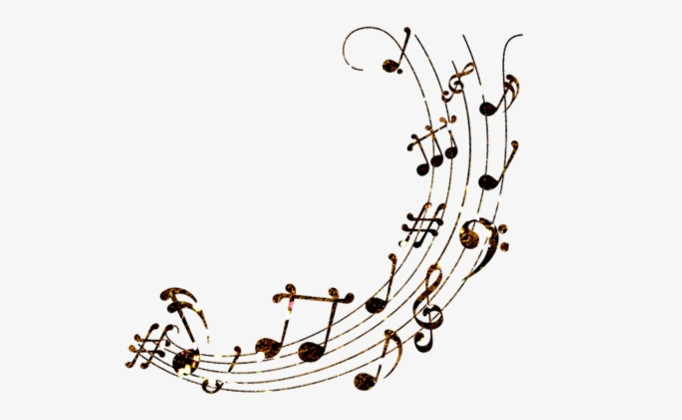Everyone knows musical notes. The Do, the Re, the Mi, and all the others. Very good. But what if I told you that a note has a few secrets hidden inside?
 Notes and staff Well yes. To understand well, for example, why we call certain sounds of the sound spectrum C or why the same C sounds different on a guitar or a sax or a piano, we must explain some things first.
Notes and staff Well yes. To understand well, for example, why we call certain sounds of the sound spectrum C or why the same C sounds different on a guitar or a sax or a piano, we must explain some things first.
What is a musical note?
A musical note is a defined sound pitch, lower or higher, that receives a specific name and has a specific duration. This is a short definition.
Characteristics of musical notes
The first thing we must be clear about is that a note is a sound. Up to this point, nothing extraordinary. A sound is a vibration of air that reaches our ears and ends up in the brain decoded as something recognizable. We have to understand that they really exist and we could name, if we wanted, as many different notes as possible. possible air vibrations, in the range that our ear is physically prepared to perceive. Each note has a certain duration, which is known as musical figures. Those names of notes that we know and the number of air vibrations per second that we relate to each of them have not always been nor are they an absolute truth, but rather an agreement between musicians of a specific area and time. This issue is what we identify with the word and the concept tuning.
Tunings
The history of tuning musical instruments is long and winding. To begin with, from very ancient times there was a technical difficulty in the manufacture of instruments, a lack of precision due to the technologies of the past that made it almost impossible to finely calibrate the notes they could produce. String instruments, pistons and others, materials such as wood, metal and others,… Each of them with their problems, with their hardness or their inconsistency and, finally, also a difficulty in objectively measuring musical sounds with ease. . As if that were not enough, the discussions of musicians and theorists on philosophical or subjective issues, on whether the reference note of the tuning system should be 440 hertz or 442 or another vibration per second.
 Tuning fork to tune In short, and in order not to prolong this agony any longer, we will say that finally, the design and manufacture of musical instruments was improved, the equal temperament As the predominant tuning system and the reference note, A was established at 440 hertz. This is the standard today.
Tuning fork to tune In short, and in order not to prolong this agony any longer, we will say that finally, the design and manufacture of musical instruments was improved, the equal temperament As the predominant tuning system and the reference note, A was established at 440 hertz. This is the standard today.
Harmonics and notes
And here we are with our twelve notes that almost everyone knows. Twelve notes that complete the sound space of what we call octave, from which the twelve names are repeated again, both ascending, that is, higher notes, and descending, lower notes. C, C# (also called D b), D, D# (or E b), E, F, F# (or G b), G, G# (or A b), A, A# (or B b) and Yes. 12 notes. With those notes we compose melodies, often based on musical scales, we also create very varied rhythms or apply harmonies and chords following our instinct or our taste, the famous inspiration and, probably some musical theory, either because we have studied it or by pure imitation. Summarizing the issue, the relationships between these notes, their duration, their timbre and other possible variants is what we call music.
Timbre and the harmonic series
Returning to the musical notes themselves, what our ear perceives as a single thing, as a single sound, believe it or not, is actually made up of a bunch of them sounding at the same time. Let's explore this mind-blowing issue. It turns out that each sound we hear is many sounds, infinite, in theory. To explain it without many technicalities, each sound emitted, each note played by an instrument, for example, each one of them causes with its fundamental sound an ascending series of other varied higher notes that sound with it and that, together with that first sound They make up the specific qualities of that note or sound produced by that precise instrument, and no other. Each of those sounds is a harmonic. And the first, in addition to being the one that receives the name of the note, we will also call it fundamental harmonic.
 First 16 harmonics of C The series that is generated when producing any note is called the harmonic series and is the key for us to hear the same note played on different instruments with different qualities. What we call the ring. The characteristic timbre of each instrument adds to the potential richness of the music. A piano playing the middle C of the piano, for example, will cause a characteristic sound that will be made up of all its harmonics sounding at the same time as a single thing and each of those harmonics with a certain strength and presence. The same C, on a guitar, for example, will sound very similar, but different, since the same harmonics will add another configuration of different strengths and intensities. Our ear will recognize, without much effort, that the same C is being played by different instruments.
First 16 harmonics of C The series that is generated when producing any note is called the harmonic series and is the key for us to hear the same note played on different instruments with different qualities. What we call the ring. The characteristic timbre of each instrument adds to the potential richness of the music. A piano playing the middle C of the piano, for example, will cause a characteristic sound that will be made up of all its harmonics sounding at the same time as a single thing and each of those harmonics with a certain strength and presence. The same C, on a guitar, for example, will sound very similar, but different, since the same harmonics will add another configuration of different strengths and intensities. Our ear will recognize, without much effort, that the same C is being played by different instruments.
Conclusions
As you have seen, behind a simple name and a simple note there is an entire film of science and history through the centuries. For any of us it is natural and unsophisticated to hear one of those notes and, if our ears are prepared, even recognize them and name them. This is so and it is fine that way. There is no need to know the physics of sound to hum a melody or sing a song of collective euphoria with our friends, for example. But, at the same time, it doesn't hurt to understand the why of things, even the most everyday and harmless ones. If you compose music or write songs, you will not have this type of information and knowledge to spare. Especially in this 21st century, where the manipulation of sound, of these elements that we have mentioned and others, is developing at full speed thanks to digital technologies, understanding what a note is, what type of sound it is and how you can use and twist it For your creative purposes it is, more than useful, necessary. Let's not talk anymore. It's time to write your new song. #mailpoet_form_3 .mailpoet_form { } #mailpoet_form_3 .mailpoet_column_with_background { padding: 10px; } #mailpoet_form_3 .mailpoet_form_column:not(:first-child) { margin-left: 20px; } #mailpoet_form_3 .mailpoet_paragraph { line-height: 20px; margin-bottom: 20px; } #mailpoet_form_3 .mailpoet_segment_label, #mailpoet_form_3 .mailpoet_text_label, #mailpoet_form_3 .mailpoet_textarea_label, #mailpoet_form_3 .mailpoet_select_label, #mailpoet_form_3 .mailpoet_radio_label, #mailpoet_form_3 .mailpoet_checkbox_label, #mailpoet_form_3 .mailpoet_list_label, #mailpoet_form_3 .mailpoet_date_label { display: block; font-weight: normal; } #mailpoet_form_3 .mailpoet_text, #mailpoet_form_3 .mailpoet_textarea, #mailpoet_form_3 .mailpoet_select, #mailpoet_form_3 .mailpoet_date_month, #mailpoet_form_3 .mailpoet_date_day, #mailpoet_form_3 .mailpoet_date_year, #mailpoet_form_3 .mailpoet_date { display: block; } #mailpoet_form_3 .mailpoet_text, #mailpoet_form_3 .mailpoet_textarea { width: 200px; } #mailpoet_form_3 .mailpoet_checkbox { } #mailpoet_form_3 .mailpoet_submit { } #mailpoet_form_3 .mailpoet_divider { } #mailpoet_form_3 .mailpoet_message { } #mailpoet_form_3 .mailpoet_form_loading { width: 30px; text-align: center; line-height: normal; } #mailpoet_form_3 .mailpoet_form_loading > span { width: 5px; height: 5px; background-color: #5b5b5b; }#mailpoet_form_3{border: 1px solid #fcb900;border-radius: 40px;text-align: center;}#mailpoet_form_3 form.mailpoet_form {padding: 20px;}#mailpoet_form_3{width: 70%;}#mailpoet_form_3 .mailpoet_message {margin : 0; padding: 0 20px;}#mailpoet_form_3 .mailpoet_paragraph.last {margin-bottom: 0} @media (max-width: 500px) {#mailpoet_form_3 {background-image: none;}} @media (min-width: 500px) { #mailpoet_form_3 .last .mailpoet_paragraph:last-child {margin-bottom: 0}} @media (max-width: 500px) {#mailpoet_form_3 .mailpoet_form_column:last-child .mailpoet_paragraph:last-child {margin-bottom: 0}} Please leave this field emptyDo you write songs or would you like to?
I have read and accept the Privacy Policy With the Guide «The journey of a song» as a gift Check your inbox or spam folder to confirm your subscription.
